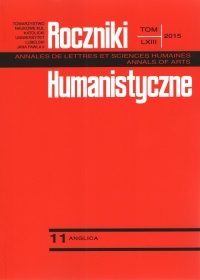Metanalysis and phonaesthesia as sources of secondary initials in Irish
Abstrakt
Metanaliza i fonestezja jako źródła spółgłosek inicjalnych w irlandzkim
Celem artykułu jest wskazanie źródeł powstania trzech irlandzkich spółgłosek inicjalnych, których obecność na początku danych wyrazów nie może być uzasadniona etymologicznie. Dyskusja dotyczy segmentów n-, t- i s-. Dowiedziono, że dwie pierwsze samogłoski, poprzez proces metanalizy (Jespersen 1914), zostały błędnie „przeniesione” z końcówki przedimka określającego an, an t- do inicjalnej pozycji następującego po nim słowa. Z kolei spólgłoska s- pełni funkcję fonestemu (Bloomfield 1933), a zatem segmentu wspólnego dla pewnej semantycznie zdefiniowanej grupy wyrazów. Na podstawie przykładów z różnych języków indoeuropejskich wykazano, że spółgłoska s- nadaje wyrazom zwykle koloryt pejoratywny.
Bibliografia
Allan, Keith. 1986. Linguistic Meaning. London and New York: Routledge & Kegan Paul.
Anderson Earl R. 1998. A Grammar of Iconism. Madison, NJ: Fairleigh Dickinson University Press.
Ball, Martin. J. and Nicole Miller. 1992. Mutations in Welsh. London: Routledge.
Bloomfield, Leonard. 1933. Language. Chicago: University of Chicago Press.
Bolinger, Dwight. 1950. “Rime, Assonance and Morpheme analysis.” Word 6/2: 117-136.
Breatnach, Risteard B. 1947. The Irish of Ring, Co. Wateford. Dublin: The Dublin Institute for Advanced Studies.
Breatnach, Risteard B. 1964/66. “A question of methods.” Éigse 11: 157–65.
Campbell, Lyle. 2013. Historical Linguistics. Edinburgh: Edinburgh University Press.
Crystal, David. 2003. A Dictionary of Linguistics and Phonetics. Oxford: Blackwell.
de Bhaldraithe, Tomás. 1945. The Irish of Cois Fhairrge, Co. Galway: a Phonetic Study. Dublin: The Dublin Institute for Advanced Studies.
de Búrca, Sean. 1958. The Irish of Tourmakeady, Co. Mayo: a phonemic study. Dublin: The Dublin Institute for Advanced Studies.
Firth, John R. 1930. Speech. London: Benn.
Hamilton, John N. 1974. The Irish of Tory Island. Belfast: Institute of Irish Studies, The Queen’s University of Belfast.
Hickey, Raymond. 2011. The Dialects of Irish. Study in a Changing Landscape. Berlin: de Gruyter Mouton.
Holmer, Nils M. 1962. The Dialects of Co. Clare. Part I. Royal Irish Academy Todd Lecture Series, vol. 19. Dublin: Royal Irish Academy.
Jespersen, Otto. 1904. Lehrbuch der Phonetic. Leipzig: Teubner.
Jespersen, Otto. 1922. Language: Its Nature and Development. New York: Henry Holt and Company.
Małocha, Agnieszka. 1994. “Żydowskie zapożyczenia leksykalne w socjolekcie przestępczym.” In J. Anusiewicz, B. Siciński: Języki subkultur. Wrocław: Wiedza o Kulturze, 135-170.
Markel, Norman N. and Eric P. Hamp. 1960. “Connotative meanings of certain phoneme sequences.” Studies in Linguisics 15: 47-61.
Matiello, Elisa. 2013. Extra-grammatical morphology in English: Abbreviations, Blends, Reduplicatives, and Related Phenomena. Berlin: Mouton de Gruyter.
Miller, D. Gary. 2014. English Lexicogenesis. OUP Oxford.
Mobbs, Ian. 2007. “Phonoaesthesia, diachronic semantics, and the faculties of performance.” https://www.academia.edu/234791/Phonaesthesia_and_the_faculties_of_performance, 10.09.2015.
Nevins, Andrew and Bert Vaux. 2003. “Metalingustic, Shmetalinguistic: The Phonology of Shm-Reduplication.” Proceedings from the Annual Meeting of the Chicago Linguistic Society 39(1): 702-721.
Ó Cuív, Brian. 1944. The Irish of West Muskerry, Co. Cork: a Phonetic Study. Dublin: The Dublin Institute for Advanced Studies.
Ó Dónaill, Niall. 1977. Foclóir Gaeilge- Béarla. Baile Átha Cliath: Oifig an tSoláthair.
Ohala, John J. 1997. “Sound symbolism.” Proc. 4th Seoul International Conference on Linguistics [SICOL] 11-15 Aug 1997. 98-103.
Ó Siadhail, Mícheál. 1989. Modern Irish: Grammatical Structure and Dialectical Variation. Cambridge: Cambridge University Press.
Simpsons, John A. and Edmund S.C. Weiner. 1989. The Oxford English Dictionary. Oxford: Clarendon Press.
Quiggin, Edmund C. 1906. A Dialect of Donegal. Cambridge: Cambridge University Press.
Philps, Dennis. 2011. “Reconsidering phonæsthemes: Submorphemic invariance in English ‘sn- words’.” Lingua 121: 1121-1137.
Rangell, Leo. 1954. “The Psychology of poise — with a special elaboration on the psychic significance of the snout or peri-oral region.” International Journal of Psycholinguistics 35, 313-332.
Sommerfelt, Alf. 1922. The dialect of Torr, Co. Donegal. Christiania: Dybwad.
Southern, Mark R. V. 2005. Contagious Couplings: Transmission of Expressives in Yiddish Echo Phrases. Westport: Greenwood Publishing House.
Southern, Mark R.V. 1999. “Sub-Grammatical Survival: Indo-European s-mobile and its Regeneration in Germanic.” Journal of Indo-European Sudies Monograph 34.
Toner, Gregory, Grigory Bondarenko, Maxim Fomin, and Thomas Torma. 2007. An Electronic Dictionary of the Irish Language. www.dil.ie.
Wright, Joseph. (Ed.). 1898-1905. The English Dialect Dictionary, vol. I-VI. London: H. Frowde.
Żabowska, Magdalena. 2011. “O tzw. dopowiedzeniach zaprzeczających.” Prace Filologiczne LX: 353–364.
Online corpora:
NKJP: National Corpus of the Polish Language, www.nkjp.pl.
PELCRA Polish English Language Corpora for Research and Application, www.pelcra.pl.
COCA The Corpus of Contemporary American English: 450 million words, 1990-present, corpus.byu.edu/coca/.
COHA The Corpus of Historical American English: 400 million words, 1810-2009, corpus. byu.edu/coha/.
Copyright (c) 2015 Roczniki Humanistyczne

Utwór dostępny jest na licencji Creative Commons Uznanie autorstwa – Użycie niekomercyjne – Bez utworów zależnych 4.0 Międzynarodowe.





